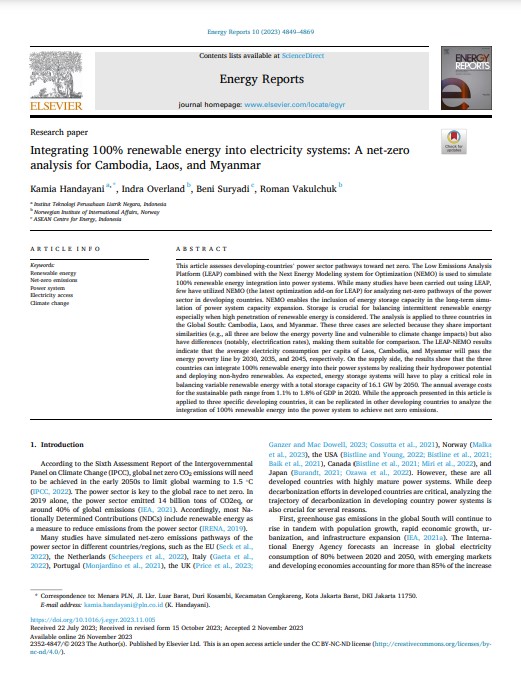
Keyword(s)
Author(s)
a) Kamia Handayani, b) Indra Overland, c) Beni Suryadi, b) Roman Vakulchuk
Publisher
Published Date
Access
DOI
This article assesses developing-countries’ power sector pathways toward net zero. The Low Emissions Analysis Platform (LEAP) combined with the Next Energy Modeling system for Optimization (NEMO) is used to simulate 100% renewable energy integration into power systems. While many studies have been carried out using LEAP, few have utilized NEMO (the latest optimization add-on for LEAP) for analyzing net-zero pathways of the power sector in developing countries. NEMO enables the inclusion of energy storage capacity in the long-term simulation of power system capacity expansion. Storage is crucial for balancing intermittent renewable energy especially when high penetration of renewable energy is considered. The analysis is applied to three countries in the Global South: Cambodia, Laos, and Myanmar. These three cases are selected because they share important similarities (e.g., all three are below the energy poverty line and vulnerable to climate change impacts) but also have differences (notably, electrification rates), making them suitable for comparison. The LEAP-NEMO results indicate that the average electricity consumption per capita of Laos, Cambodia, and Myanmar will pass the energy poverty line by 2030, 2035, and 2045, respectively. On the supply side, the results show that the three countries can integrate 100% renewable energy into their power systems by realizing their hydropower potential and deploying non-hydro renewables. As expected, energy storage systems will have to play a critical role in balancing variable renewable energy with a total storage capacity of 16.1 GW by 2050. The annual average costs for the sustainable path range from 1.1% to 1.8% of GDP in 2020. While the approach presented in this article is applied to three specific developing countries, it can be replicated in other developing countries to analyze the integration of 100% renewable energy into the power system to achieve net zero emissions.